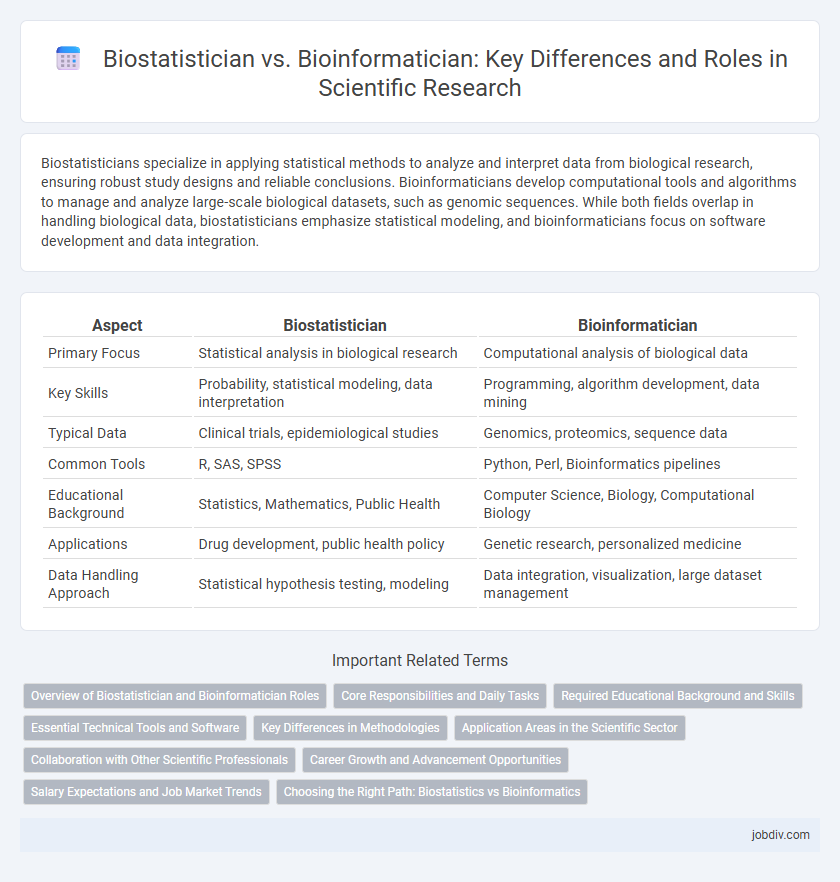Biostatisticians specialize in applying statistical methods to analyze and interpret data from biological research, ensuring robust study designs and reliable conclusions. Bioinformaticians develop computational tools and algorithms to manage and analyze large-scale biological datasets, such as genomic sequences. While both fields overlap in handling biological data, biostatisticians emphasize statistical modeling, and bioinformaticians focus on software development and data integration.
Table of Comparison
| Aspect | Biostatistician | Bioinformatician |
|---|---|---|
| Primary Focus | Statistical analysis in biological research | Computational analysis of biological data |
| Key Skills | Probability, statistical modeling, data interpretation | Programming, algorithm development, data mining |
| Typical Data | Clinical trials, epidemiological studies | Genomics, proteomics, sequence data |
| Common Tools | R, SAS, SPSS | Python, Perl, Bioinformatics pipelines |
| Educational Background | Statistics, Mathematics, Public Health | Computer Science, Biology, Computational Biology |
| Applications | Drug development, public health policy | Genetic research, personalized medicine |
| Data Handling Approach | Statistical hypothesis testing, modeling | Data integration, visualization, large dataset management |
Overview of Biostatistician and Bioinformatician Roles
Biostatisticians specialize in designing studies and analyzing biological data using statistical theories and methodologies, often working with clinical trials and epidemiological research. Bioinformaticians develop computational tools and algorithms to interpret complex biological datasets, such as genomics and proteomics information. Both roles require expertise in biology and data analysis, but biostatisticians emphasize statistical frameworks while bioinformaticians focus on software development and data integration.
Core Responsibilities and Daily Tasks
Biostatisticians primarily design experiments, develop statistical models, and analyze biological data to interpret research findings and support decision-making in clinical trials or public health studies. Bioinformaticians focus on creating algorithms, managing large-scale genomic datasets, and developing computational tools to understand molecular biology and genetic sequences. Both roles require proficiency in statistical software and programming, but biostatisticians emphasize statistical inference while bioinformaticians specialize in computational biology and data integration.
Required Educational Background and Skills
Biostatisticians typically require a strong foundation in statistics, mathematics, and biology, often holding advanced degrees such as a Master's or Ph.D. in Biostatistics or Public Health with specialized coursework in statistical modeling and experimental design. Bioinformaticians usually possess expertise in computer science, programming, and molecular biology, requiring degrees in Bioinformatics, Computational Biology, or related fields with skills in coding languages like Python, R, and proficiency in genomic data analysis. Both roles demand proficiency in data interpretation and analytical software, but biostatisticians focus more on statistical methodologies while bioinformaticians emphasize algorithm development and biological data integration.
Essential Technical Tools and Software
Biostatisticians primarily utilize software such as R, SAS, and STATA for statistical analysis and modeling of biological data, emphasizing hypothesis testing and data interpretation. Bioinformaticians rely on tools like Python, Perl, BLAST, and genome browsers to analyze complex genetic sequences and large-scale biological datasets, integrating computational algorithms and database querying. Both roles require proficiency in data visualization platforms and high-throughput data management systems tailored to their specific scientific datasets.
Key Differences in Methodologies
Biostatisticians apply statistical models and algorithms to analyze biological data, emphasizing hypothesis testing, experimental design, and data interpretation through rigorous quantitative methods. Bioinformaticians employ computational tools and machine learning techniques to process large-scale genomic and proteomic datasets, focusing on sequence alignment, pattern recognition, and database integration. The primary methodological distinction lies in biostatistics' reliance on classical statistics for inference, whereas bioinformatics integrates computer science and algorithm development for high-throughput biological data analysis.
Application Areas in the Scientific Sector
Biostatisticians primarily apply statistical methods to design biological experiments, analyze clinical trial data, and interpret public health studies, facilitating evidence-based decision-making in medicine and epidemiology. Bioinformaticians focus on developing algorithms, software tools, and computational models to analyze genomic sequences, protein structures, and large-scale biological datasets, advancing research in molecular biology and genetics. Both roles contribute critical expertise to personalized medicine, drug discovery, and systems biology by integrating quantitative analysis with biological insights.
Collaboration with Other Scientific Professionals
Biostatisticians collaborate extensively with epidemiologists and clinical researchers to design studies and analyze medical data, ensuring statistical rigor and validity. Bioinformaticians work closely with molecular biologists and geneticists to interpret complex genomic datasets, integrating computational tools for biological insights. Their interdisciplinary teamwork enhances the discovery and validation of scientific findings across biomedical research.
Career Growth and Advancement Opportunities
Biostatisticians often experience career growth through specialization in clinical trials, epidemiology, or regulatory affairs, with advancements leading to senior research positions or consultancy roles in healthcare and pharmaceutical industries. Bioinformaticians typically progress by developing expertise in computational biology, machine learning, and genomics, opening opportunities for leadership in R&D teams or roles in biotech startups and academic institutions. Both careers offer increasing demand driven by data-driven medical research, but bioinformatics may offer faster advancement in tech-driven environments.
Salary Expectations and Job Market Trends
Biostatisticians typically earn an average salary ranging from $75,000 to $115,000 annually, reflecting strong demand in pharmaceuticals, healthcare, and public health sectors. Bioinformaticians often command salaries between $85,000 and $130,000, driven by growth in genomics, biotechnology, and personalized medicine industries. Job market trends indicate a rising need for bioinformaticians due to advances in big data and computational biology, while biostatisticians remain essential for clinical trial design and epidemiological research.
Choosing the Right Path: Biostatistics vs Bioinformatics
Biostatistics emphasizes statistical methods for analyzing biological data, focusing on study design, clinical trials, and epidemiological research. Bioinformatics involves computational techniques for managing and interpreting large-scale genomic, proteomic, and molecular datasets using algorithms and software development. Choosing the right path depends on whether one prefers mathematical modeling and statistical inference or algorithm development and biological data integration.
Biostatistician vs Bioinformatician Infographic

 jobdiv.com
jobdiv.com